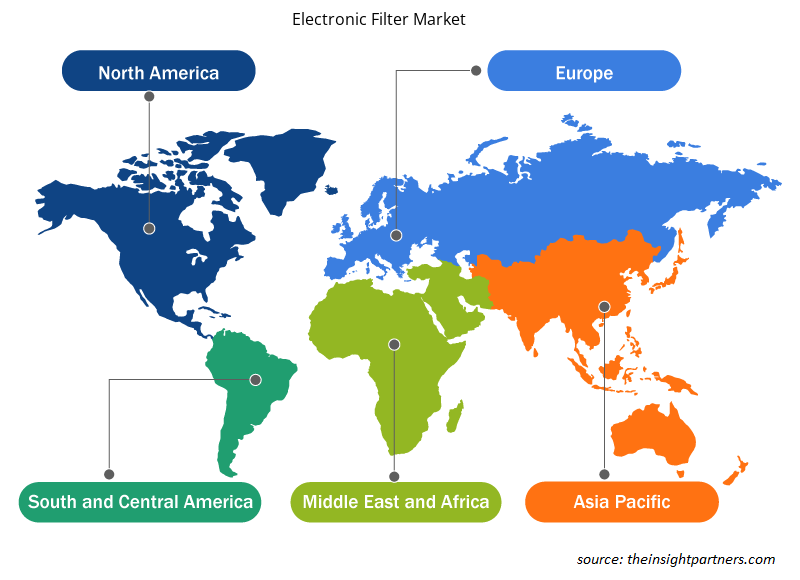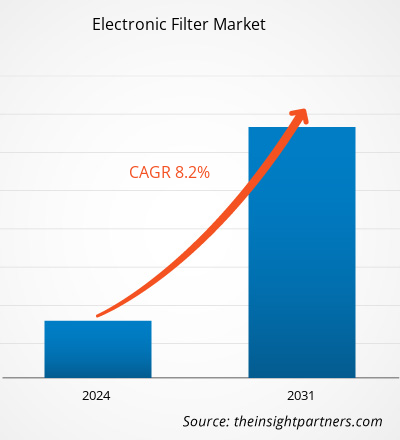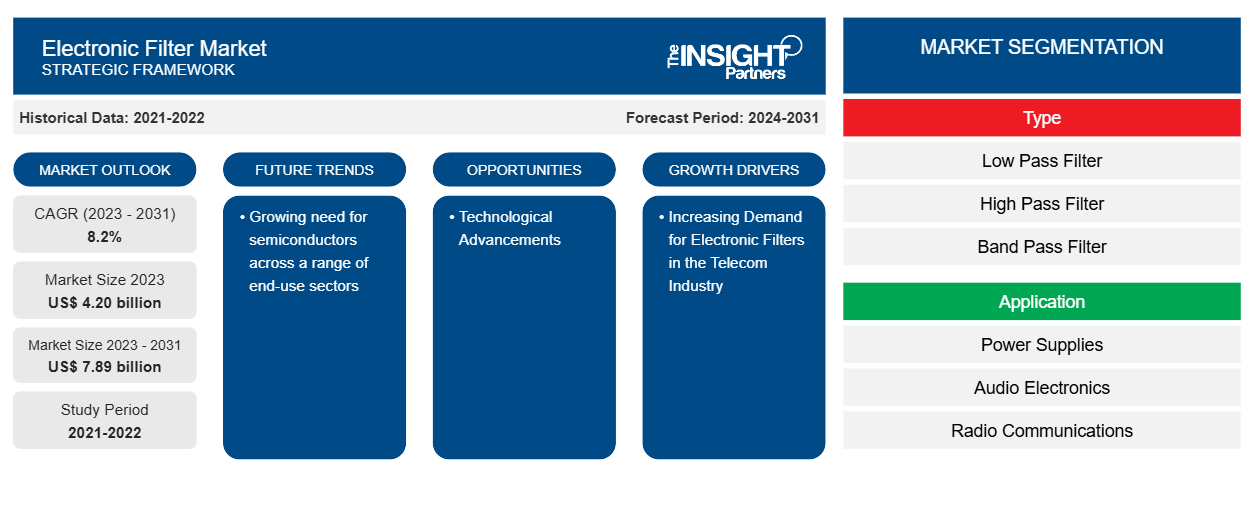La taille du marché mondial des filtres électroniques devrait passer de 4,20 milliards USD en 2023 à 7,89 milliards USD d'ici 2031 ; elle devrait croître à un TCAC de 8,2 % de 2023 à 2031. Le besoin croissant de semi-conducteurs dans une gamme de secteurs d'utilisation finale devrait rester l'une des principales tendances du marché des filtres électroniques.
Analyse du marché des filtres électroniques
Le marché des filtres électroniques est principalement stimulé par la demande croissante de filtres électroniques dans le secteur des télécommunications. En outre, l'introduction de la 5G et l'utilisation croissante des réseaux LTE, en particulier dans les pays émergents, sont les principaux moteurs de l'expansion du secteur mondial des télécommunications tout en contribuant également à la croissance du marché des filtres électroniques.
Aperçu du marché des filtres électroniques
Un filtre électronique désigne un circuit ou un dispositif utilisé pour modifier, remodeler ou rejeter des fréquences spécifiques dans un signal électrique tout en laissant passer les fréquences souhaitées. Les filtres sont largement utilisés dans divers secteurs, notamment les alimentations électriques, l'électronique audio, les communications radio et les systèmes de traitement du signal et de l'image. Il existe différents types de filtres, notamment les filtres passe-bas, passe-haut, passe-bande et coupe-bande. Les filtres ont diverses applications dans les alimentations électriques, l'électronique audio, les communications radio et les systèmes de traitement du signal et de l'image. Ils peuvent être classés comme passifs ou actifs, selon les composants utilisés dans leur construction.
Personnalisez ce rapport en fonction de vos besoins
Vous bénéficierez d'une personnalisation gratuite de n'importe quel rapport, y compris de certaines parties de ce rapport, d'une analyse au niveau des pays, d'un pack de données Excel, ainsi que d'offres et de remises exceptionnelles pour les start-ups et les universités.
-
Obtenez les principales tendances clés du marché de ce rapport.Cet échantillon GRATUIT comprendra une analyse de données, allant des tendances du marché aux estimations et prévisions.
Facteurs moteurs et opportunités du marché des filtres électroniques
La demande croissante de filtres électroniques dans le secteur des télécommunications devrait favoriser le marché
Le secteur des télécommunications évolue progressivement en raison de l'évolution constante de l'environnement technologique et de l'utilisation croissante des smartphones et autres appareils connectés dans le monde entier. En outre, l'introduction de la 5G et l'utilisation croissante des réseaux LTE, en particulier dans les pays émergents, sont les principaux moteurs de l'expansion du secteur mondial des télécommunications. Le besoin de filtres électroniques dans le secteur mondial des télécommunications est stimulé par les fortes prévisions de croissance du secteur, qui résultent de l'expansion de la pénétration des réseaux et de la demande des clients en contenu numérique.
Progrès technologiques
De nos jours, les filtres électroniques sont associés à d’autres technologies de pointe comme la robotique, l’apprentissage automatique et l’intelligence artificielle (IA). Cette connexion permet d’améliorer l’automatisation et d’accroître les fonctionnalités dans toute une gamme d’applications. Les filtres basés sur l’intelligence artificielle, par exemple, sont capables d’analyser des modèles de données complexes et de s’ajuster en temps réel pour maximiser l’efficacité.
Analyse de segmentation du rapport sur le marché des filtres électroniques
Segments clés ayant contribué à la dérivation du type d’analyse et de l’application du marché des filtres électroniques.
- En fonction du type, le marché est divisé en filtre passe-bas, filtre passe-haut, filtre passe-bande, filtre coupe-bande et filtre passe-tout. Le segment des filtres passe-bas détenait une part de marché plus importante en 2023.
- En fonction des applications, le marché est divisé en alimentations électriques, électronique audio , communications radio et conversion analogique-numérique. Le segment de l'électronique audio détenait une part de marché plus importante en 2023.
Analyse des parts de marché des filtres électroniques par zone géographique
La portée géographique du rapport sur le marché des filtres électroniques est principalement divisée en cinq régions : Amérique du Nord, Asie-Pacifique, Europe, Moyen-Orient et Afrique, et Amérique du Sud/Amérique du Sud et centrale. L'Amérique du Nord a dominé le marché des filtres électroniques en 2023. L'un des principaux facteurs propulsant le marché des filtres électroniques est le pronostic de développement optimiste du secteur des télécommunications en Amérique du Nord. Le marché est en expansion en raison du besoin croissant de filtres électroniques de l'industrie des télécommunications.
Aperçu régional du marché des filtres électroniques
Les tendances régionales et les facteurs influençant le marché des filtres électroniques tout au long de la période de prévision ont été expliqués en détail par les analystes d’Insight Partners. Cette section traite également des segments et de la géographie du marché des filtres électroniques en Amérique du Nord, en Europe, en Asie-Pacifique, au Moyen-Orient et en Afrique, ainsi qu’en Amérique du Sud et en Amérique centrale.

- Obtenez les données régionales spécifiques au marché des filtres électroniques
Portée du rapport sur le marché des filtres électroniques
| Attribut de rapport | Détails |
|---|---|
| Taille du marché en 2023 | 4,20 milliards de dollars américains |
| Taille du marché d'ici 2031 | 7,89 milliards de dollars américains |
| Taux de croissance annuel composé mondial (2023-2031) | 8,2% |
| Données historiques | 2021-2022 |
| Période de prévision | 2024-2031 |
| Segments couverts |
Par type
|
| Régions et pays couverts |
Amérique du Nord
|
| Leaders du marché et profils d'entreprises clés |
|
Densité des acteurs du marché des filtres électroniques : comprendre son impact sur la dynamique commerciale
Le marché des filtres électroniques connaît une croissance rapide, tirée par la demande croissante des utilisateurs finaux en raison de facteurs tels que l'évolution des préférences des consommateurs, les avancées technologiques et une plus grande sensibilisation aux avantages du produit. À mesure que la demande augmente, les entreprises élargissent leurs offres, innovent pour répondre aux besoins des consommateurs et capitalisent sur les tendances émergentes, ce qui alimente davantage la croissance du marché.
La densité des acteurs du marché fait référence à la répartition des entreprises ou des sociétés opérant sur un marché ou un secteur particulier. Elle indique le nombre de concurrents (acteurs du marché) présents sur un marché donné par rapport à sa taille ou à sa valeur marchande totale.
Les principales entreprises opérant sur le marché des filtres électroniques sont :
- ABB Ltée.
- Société AVX
- BLOCK Transformatoren-Elektronik GmbH
- Société Captor
- Anritsu
- CD Automation Royaume-Uni Ltd.
Avis de non-responsabilité : les sociétés répertoriées ci-dessus ne sont pas classées dans un ordre particulier.

- Obtenez un aperçu des principaux acteurs du marché des filtres électroniques
Actualités et développements récents du marché des filtres électroniques
Le marché des filtres électroniques est évalué en collectant des données qualitatives et quantitatives après des recherches primaires et secondaires, qui comprennent d'importantes publications d'entreprise, des données d'association et des bases de données. Voici une liste des évolutions du marché :
- En février 2024, ABB India lance son variateur compact de nouvelle génération, l'ACH180, pour les équipements CVC (chauffage, ventilation, climatisation et réfrigération). Dernier ajout à la gamme de variateurs CVC d'ABB, l'ACH180 permet un contrôle expert des moteurs à haut rendement tout en utilisant une conception compacte pour des économies d'espace, des dépenses d'investissement réduites et une mise en service plus facile. Avec un filtre intégré pour réduire les émissions à haute fréquence, il permet d'utiliser le variateur dans des environnements industriels ou domestiques sans avoir besoin d'acheter et d'installer des filtres externes supplémentaires.
(Source : ABB, Communiqué de presse, 2024)
Rapport sur le marché des filtres électroniques et livrables
Le rapport « Taille et prévisions du marché des filtres électroniques (2021-2031) » fournit une analyse détaillée du marché couvrant les domaines ci-dessous :
- Taille du marché et prévisions aux niveaux mondial, régional et national pour tous les segments de marché clés couverts par le périmètre
- Dynamique du marché, comme les facteurs moteurs, les contraintes et les opportunités clés
- Principales tendances futures
- Analyse détaillée des cinq forces de PEST/Porter et SWOT
- Analyse du marché mondial et régional couvrant les principales tendances du marché, les principaux acteurs, les réglementations et les développements récents du marché
- Analyse du paysage industriel et de la concurrence couvrant la concentration du marché, l'analyse de la carte thermique, les principaux acteurs et les développements récents
- Profils d'entreprise détaillés
- Analyse historique (2 ans), année de base, prévision (7 ans) avec TCAC
- Analyse PEST et SWOT
- Taille du marché Valeur / Volume - Mondial, Régional, Pays
- Industrie et paysage concurrentiel
- Ensemble de données Excel
Rapports récents
Témoignages
Raison d'acheter
- Prise de décision éclairée
- Compréhension de la dynamique du marché
- Analyse concurrentielle
- Connaissances clients
- Prévisions de marché
- Atténuation des risques
- Planification stratégique
- Justification des investissements
- Identification des marchés émergents
- Amélioration des stratégies marketing
- Amélioration de l'efficacité opérationnelle
- Alignement sur les tendances réglementaires























 Obtenez un échantillon gratuit pour - Marché des filtres électroniques
Obtenez un échantillon gratuit pour - Marché des filtres électroniques